Southend-on-Sea Corporation Tramways
History
In the late 1890s, Southend-on-Sea Corporation was approached by numerous tramway promoters seeking their support for various schemes, but after the corporation elected to build a municipal electric supply system, it was perhaps only to be expected that it would eventually opt to construct and operate a municipal tramway system too. Powers were duly obtained for a 3ft 6ins-gauge overhead electric system — on the 8th September 1899 — with construction starting in February of the following year; unfortunately, there were major delays during the building, the opening taking place 17 months later on the 19th July 1901.
Like many seaside systems, Southend's had to cope with large numbers of passengers during the summer, and much fewer outside of this, the town not having much in the way of a significant 'non-tourist' industry and workforce. The tramway was initially handicapped by a poor choice of tramcars, not only ordering insufficient vehicles, but also designs that were unsuitable for the heavy holiday loadings, many potential passengers choosing to walk rather than risk a crush in the hopelessly overloaded tramcars. A more onerous problem came in the form of the trackbed, which sank and broke up due to a combination of poor construction and unhelpful geology, the rectification of which required heavy expenditure. As a result of these issues, and several other difficulties — such as faulty tramcar bogies and a service that continually ran at a loss (Prittlewell) — the entire concern was not able able to pay its way until as late as 1908.
Despite these struggles, the corporation understood the root causes and stayed the course, improving the fleet through rebuilding, as well as purchasing new, higher capacity vehicles. Key sections of track were doubled to improve traffic flows and the system was eventually extended, initially in 1908, and then again in 1912/13/14; the corporation also grasped the thorny nettle of the Prittlewell service, which was a constant drain on the finances, closing the North Rd section on the 22nd January 1912.
In July 1912, the corporation acquired powers to run motorbuses, the first tramway feeder services being introduced on the 25th June 1914, by which time the concern was making impressive profits, and returning significant sums to the council in the way of rate relief.
The system reached its maximum of 9.22 miles with the opening of a new loop line connecting Southchurch and Thorpe Bay on the 16th July 1914, much of it on reserved track formations. The hub of the tramway system was Victoria Circus, with lines running: westwards along London Rd, past the Cricketers Arms and the Plough Hotel, then along Leigh Rd to a terminus outside St Clements Church in Leigh; northwards along Victoria Avenue, past the Great Eastern Railway's Victoria Station to Prittlewell, the line then returning to the Cricketers Arms via North Rd, where it joined the Leigh line; eastwards along Southchurch Rd, past Southchurch Avenue to Southchurch, then along Southchurch Boulevard to Bournes Green, where it turned southwards to Thorpe Bay, via Thorpe Hall Avenue and Thorpe Boulevard, before returning westwards along the Esplanade, and northwards (at the Kursaal) along Southchurch Avenue to Southchurch Rd; southwards along High St to the Middleton Hotel outside the London, Tilbury and Southend Railway's Central Station, with an anticlockwise loop off it running around the southern and eastern sides of Warrior Square to rejoin Southchurch Rd.
Like many systems, Southend's suffered during the Great War from a shortage of staff (and skills), as well as an inability to purchase new track or tramcars, or resource anything other than minimal levels of maintenance. Although many holidaymakers stayed at home, passenger loadings remained reasonably high, the loss of tourists to some extent offset by the large number of troops stationed at nearby Shoeburyness; the lack of spares eventually led to more and more tramcars becoming permanently unavailable for traffic, such that the tramway increasingly struggled to run adequate services.
The system emerged from the conflict with a large backlog of repairs and renewals, which the SSCT soon set about making good, as best it could within the constraints of post-war supply. During the 1920s, more single track sections were doubled, a loop was built around Warrior Square to alleviate the severe congestion in the High St, and the tramcar fleet was substantially rebuilt and renewed — 19 new vehicles being purchased between 1921 and 1925 — all of which was necessary to support the dramatic increase in the number of holidaymakers flocking to the town.
Despite its obvious commitment to the tramway, the corporation was also keen to explore other modes of transport, and like many towns with municipal electricity generation, its thoughts turned to trolleybus operation. A trial service involving two hired trolleybuses was introduced on the Prittlewell route on the 16th October 1925, supplementing the trams rather than replacing them. The poor condition of the track on this route eventually led to a decision to abandon the line altogether and formally replace the tram services with trolleybuses — powers to this end being granted in on the 20th April 1926 — with the last tram from Prittlewell running on 18th December 1928.
The abandonment of the Prittlewell route, and with it the trams ability to serve the population in the growing suburbs to the north, was probably the turning point in terms of the municipal transport policy; from then on, expansion and new investment tended to be focused on trolley and motorbus services. Although the tramway was subject to a series of economies, it was still reasonably well-maintained, and improvements continued to be made to the tramcar fleet, second-hand vehicles being obtained in 1934, despite the financial challenges of the Great Depression, when modest profits turned into losses.
In late 1933 or early 1934, the department's name was changed to Southend-on-Sea Corporation Transport, to reflect the corporation's expansion of trolleybus and motorbus services, the latter reintroduced on the 5th July 1932, their antecedents having been requisitioned during the Great War. Two years later, in 1934, the corporation obtained powers to expand trolleybus operation further and abandon more of the tramway.
Unfortunately, the system suffered greatly from appearing to be only modestly profitable, despite significant council investment, when it had in fact been used to service the debt incurred by a large number of costly municipal improvements (e.g. new roads alongside the boulevards and construction of the entire East Esplanade), as well as to pay for services that were nothing to do with tramway operation, the most bizarre of which were a number of municipal gardeners (along the boulevards).
It was only a matter of time before life-expired track would trigger more tram replacement, the first route to succumb being along the Boulevards, the once popular tourist circular tours falling from favour as times changed; the last tram between Southchurch Rd and Thorpe Bay ran on the 6th July 1938, motorbuses taking over the following day. Although the condition of the track on the remaining routes was a major cause for concern, the outbreak of the Second World War, which inevitably led to petrol rationing, prevented the corporation from completing the tramway abandonment.
Eventually, it became clear to the corporation and the government, that the track situation would simply not allow abandonment to wait until the end of the conflict, so the government grudgingly gave its approval, the Southchurch Rd line closing on 7th January 1942, and the last tram of all running 3 months later on the 8th April 1942 over the one remaining route between Leigh and the Kursaal.
Uniforms
Photos taken around the time of opening indicate that motormen and conductors wore single-breasted jackets with lapels, the entire ensemble, including buttons, being devoid of insignia. Caps were in a kepi-style with a stiff glossy peak; they bore 'off-the-shelf' grade badges, above which, a small badge of unknown pattern was worn, presumably bearing some kind of municipal device. These uniforms were eventually replaced (certainly by the mid-Edwardian era) by double-breasted, 'lancer-style' tunics with five pairs of buttons (narrowing from top to bottom), epaulettes (with button fastening and possibly bearing 'S C T' system initials) and upright collars; the latter carried an employee number on both sides. The caps appear to have been changed at the same time to a military style with a tensioned crown (top); they continued to carry script-lettering grade badges — Motorman and Conductor — but with the small cap badge seen in earlier photos superseded by a new shield-shaped municipal badge with a ship, above the motto 'Forti Nihil Difficile' (within a ribbon). It seems likely that both the badges and the buttons were nickel.
Around 1908, the corporation took a fairly radical decision in ordering the next issue of uniforms in a very light grey, referred to as 'German grey'. Whilst the jackets were in the usual 'lancer style', but without epaulettes, the colour gave them a strong continental flavour, quite unlike any other uniform issued by a tramway concern in the British Isles. The continental flavour was reinforced by the caps, which though still military in style, were noticeably taller than their predecessors, with the municipal shield badge worn high up under the crown of the cap. The grade badges appear also to have been dispensed with at this time. It seems however that the new style of uniform did not find favour, as a return to a fairly standard 'lancer-style' jacket — and colour — as well as cap style, appears to have been made as soon as the 'German grey' uniforms needed replacing (possibly in 1909 or perhaps 1910). The replacement jackets were very similar to the previous jackets, but seem to have been a little smarter; the only difference to the earlier issue being to the cap, which like the German grey cap, carried only the municipal shield badge.
At some point during the Great War, and following the grant of official arms to Southend-on-Sea County Borough Council (in 1915), yet another new style of cap badge was introduced, incorporating the new arms, crest, motto and supporters (a fisherman and a monk). Script-lettering grade badges — Motorman or Conductor — appear to have been reintroduced at same time, being worn beneath the new municipal badge; all badges and buttons were nickel.
By the 1930s, new double-breasted, naval-style jackets had been introduced with four pairs of closely spaced buttons, with another pair buttoning between the lapels and the collars, three waist/hip level pockets (with flaps) and lapels; the upper part of the latter (the collars) carried an employee number on the bearer's left-hand side (preceded by either an 'M' or 'C' for 'Motorman' and 'Conductor') and system initials — S C T — on the right-hand side. The script-lettering cap badges were dispensed once again at the same time.
The last change made to the uniforms was the introduction of a new chrome 'Transport' cap badge, which consisted of the municipal device beneath a ribbon containing the full system title — 'Southend-on-Sea Corporation Transport' — inlaid with green enamel, all above a lozenge containing an employee number; although the badges themselves were chrome, examples have survived with both chrome and nickel numbers. This change was probably made in 1934 or shortly thereafter.
Many photos have survived which show tramway staff wearing badge on the left breast of their jackets comprising one or more horizontal bars (up to four are known). These were probably cloth, and whilst it is not absolutely clear what their significance was, they more than likely denoted, seniority, good conduct or long service.
Staff were also issued with double-breasted greatcoats with five pairs of buttons, epaulettes (with button fastening) and high, fold-over collars; the latter were sometimes left plain, but when not, they either carried an employee number (on the bearer's left-hand side) and system initials — S C T or S S C T — on the right-hand side, or employee numbers on both sides. In the 1930s, conductors were also issued with long, double-breasted, light-coloured dust coats, which had collars of a darker colour; these were presumably for summer wear, and may have been limited to conductors working on the cross-bench cars used on the circular tours.
Photographs of inspectors tend to show them wearing double-breasted overcoats, so details of the jackets worn underneath are sketchy. The earliest surviving photograph, taken 1902, indicates that the first issue of jackets must have had lapels, as the subject's shirt and bow tie are clearly visible underneath his overcoat. The overcoat itself was double-breasted with lapels, the upper part of which (the collars) bore the grade — Inspector — in embroidered script lettering. Headgear took the form of a military style cap, which would probably have carried some form of badge, though this cannot be made out on the surviving photograph.
By the time of the 'German grey' uniform issue (c1908), inspectors were wearing typical tramway inspector garb, namely: single-breasted jackets with hidden buttons (or more likely a hook and eye affair) and upright collars; the latter bore the grade — Inspector — in embroidered script lettering. The jackets were edged in a finer material than the main body, this also being used to embellish the sleeves with chevrons. Caps were now in a kepi-style with a pom pom on top; they bore embroidered system initials — S C T — on a braided hat band. These uniforms did not however last long, several photographs from circa 1909/10 showing inspectors wearing unmarked, possibly informal jackets, along with military style caps. One photo shows a cap bearing a metal grade badge — Inspector — along with a municipal shield badge, whilst another clearly has a grade — Tramway Inspector — in embroidered script lettering.
By the time of the Great War, and possibly much earlier than this, inspectors were being issued with double-breasted jackets with four pairs of buttons (dark coloured), three waist/hip-level pockets (with flap closures) and lapels; the latter bore the grade in embroidered script lettering. Caps were in military in style, the sole badge being the post-1915 municipal arms badge. During the 1940s, inspectors were being issued with double-breasted overcoats that were very similar in style to the double-breasted jackets, i.e., with four pairs of buttons (dark coloured), three waist/hip-level pockets (with flap closures) and lapels; the latter bore the grade in embroidered script lettering. Caps were still military in style, but now carried the new municipal device badge, possibly in brass rather than nickel or chrome, and presumably worn since the end of the Great War, when it was also first issued to tramcar staff.
In common with the vast majority of UK tramway systems, Southend employed the services of female staff during the Great War — both as conductresses and as motorwomen — to replace male employees lost to the armed services. These ladies were issued with single-breasted jackets with four buttons, a waist belt (with button fastening), four pockets (with button closures), lapels and epaulettes; the lapels usually bore an employee number on both sides, whilst the epaulettes bore system initials, 'S C T', in individual nickel letters. A long, matching skirt was also worn. Headgear was the standard style of military cap worn by male staff, with the preferred arrangement of cap badges seemingly being a grade badge — Conductor or Driver — worn above an employee number (in individual metal numerals, almost certainly nickel); however, several permutations are on display in the large staff photo shown below, involving all three types of badge (grade, employee number and municipal shield).
Ladies' greatcoats were in a double-breasted 'lancer style' with five pairs of buttons (narrowing from top to bottom), epaulettes (with button closures) and high fold-over collars; the latter were usually left plain, though a studio portrait has survived (see below) with the collars clearly bearing employee numbers. Like the jackets worn underneath, the greatcoat epaulettes bore a badge of some description, possibly system initials, though these cannot be made out with certainty on the surviving photographs.
Conductresses were also employed during and after the Second World War, though whether they worked on the trams is unclear. These ladies were issued with single-breasted jackets bearing two breast pockets (with button closures) and lapels; whilst the latter were piped, they did not bear any insignia. The peaked caps were very similar to those provided to the men; they bore the same chrome and green enamel 'Transport' cap badge.
Further reading
For a history of Southend-on-Sea's tramway system, see:
- 'The Tramways of Southend-on-Sea' by V E Burrows; Advertiser Press (1965)
- 'Southend Corporation Transport: Trams, Trackless and Buses' by Richard Delahoy; Yarnacott Publications (1986).
- 'Southend-on-Sea Tramways' by Robert J Harley; Middleton Press (1994)
Images
Motormen and conductors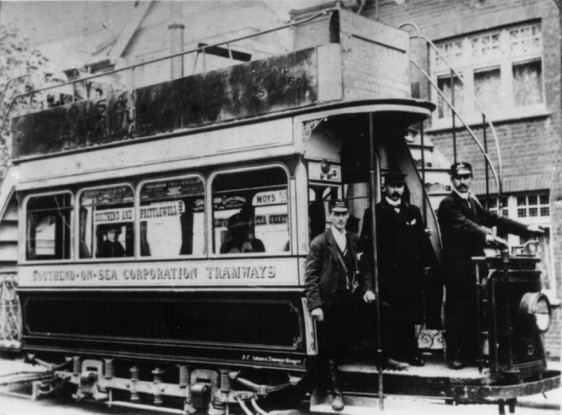
One of the 1-10 series cars (probably No 5), captured on a Prittlewell service outside the Blue Boar public house — photo undated, but believed to have been taken in 1902. Photo courtesy of the Tramways and Light Railway Society, with thanks to David Voice.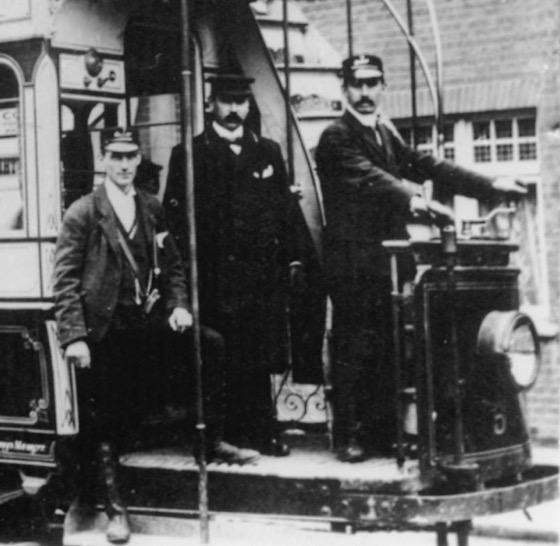
A blow-up of the above photo showing the conductor, an inspector and the motorman. The crewmen are wearing plain single-breasted jackets along with kepi-style caps; the latter bear grade badges and a small badge that presumably bore a municipal device of some description. The inspector appears to be wearing a double-breasted overcoat and a military-style cap.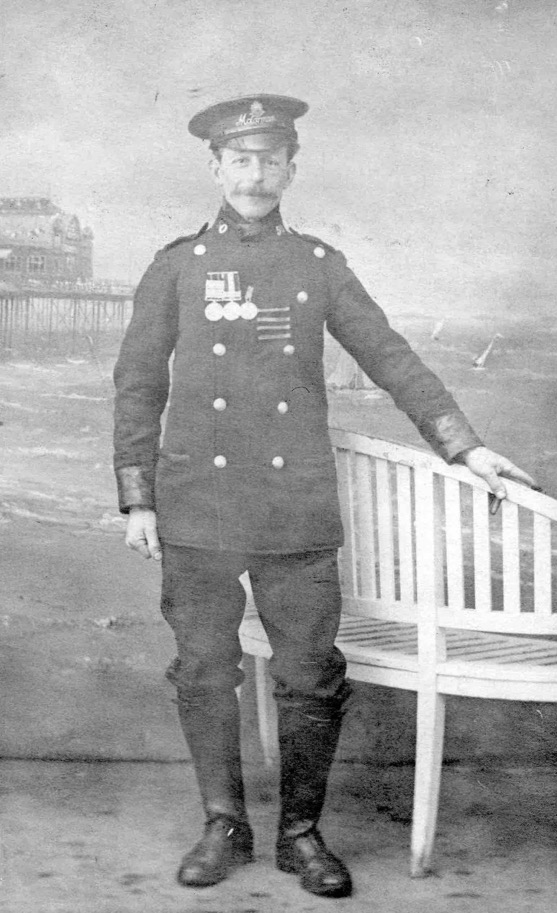
A studio portrait of a Southend motorman — photo undated, but probably taken in the mid-Edwardian era. The medals are from the Boer War, and include a Queens South Africa Medal and a Kings South Africa Medal (my thanks to Alan Cook for this information). Author's Collection.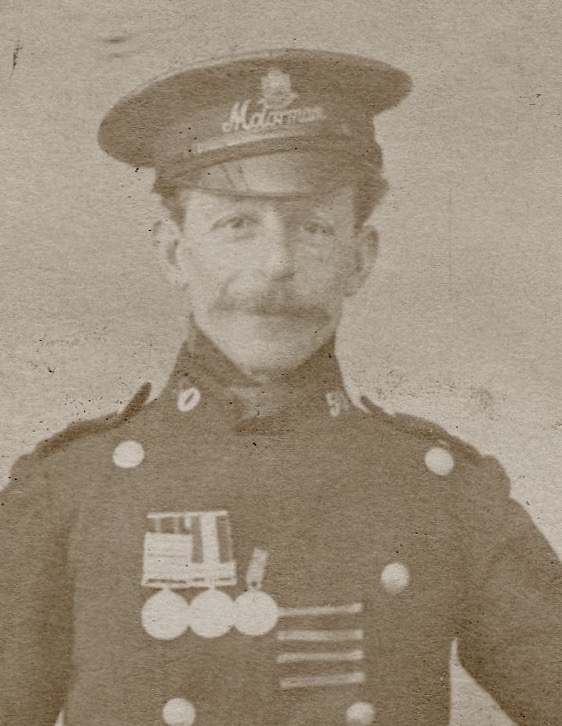
A blow-up of the above photo showing details of the collar and cap badges. By this time, double-breasted 'lancer style' tunics had replaced the earlier single-breasted jackets, and caps were military in style with a tensioned crown (top). The latter bore a new municipal arms badge, which was markedly larger than the badge seen in the earliest photos. The subject's Employee No would appear to be '50', and this is carried on both collars. The badge on his left breast, comprising four bars, is seen in many photos (with varying numbers of bars); it was probably made of cloth and possibly denoted, seniority, good conduct or long service.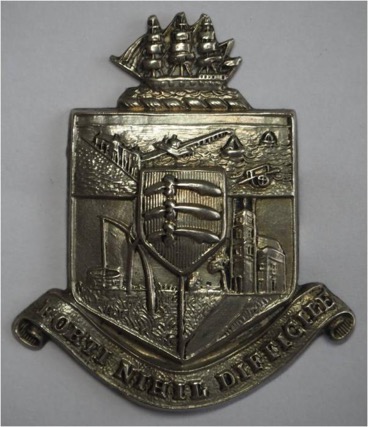
Southend-on-Sea Corporation Tramways cap badge — nickel. This appears to have been worn from around the mid-Edwardian era through to the end of the Great War. Photo courtesy of Michael Wood.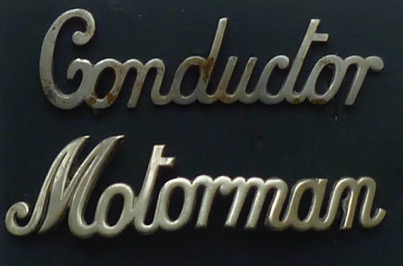
Script-lettering grade badges of the type worn by Southend-on-Sea Corporation Tramways staff from the opening (in 1901) to around 1910, and then again from the Great War to the mid-1930s — nickel. Author's Collection.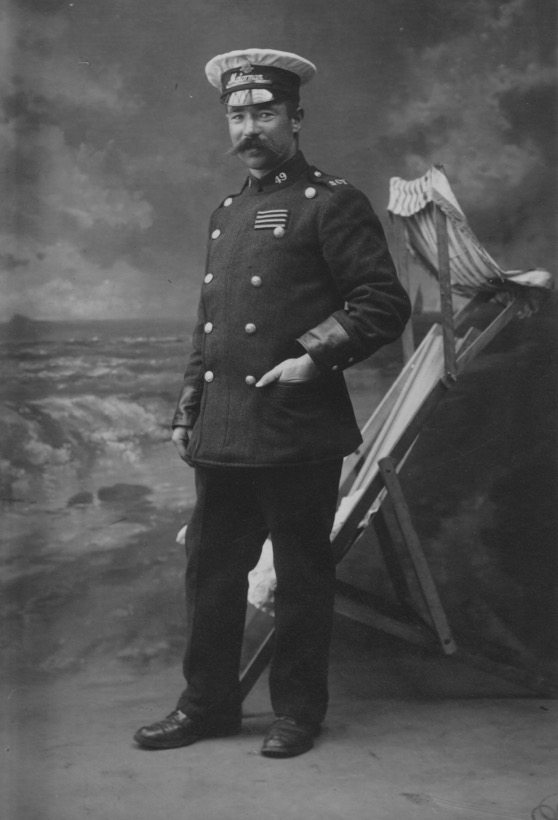
A wonderful studio portrait of SCT Motorman No 49, the studio decoration leaving no doubt as to the coastal location — photo undated, but probably taken in the mid-Edwardian era. Author's Collection.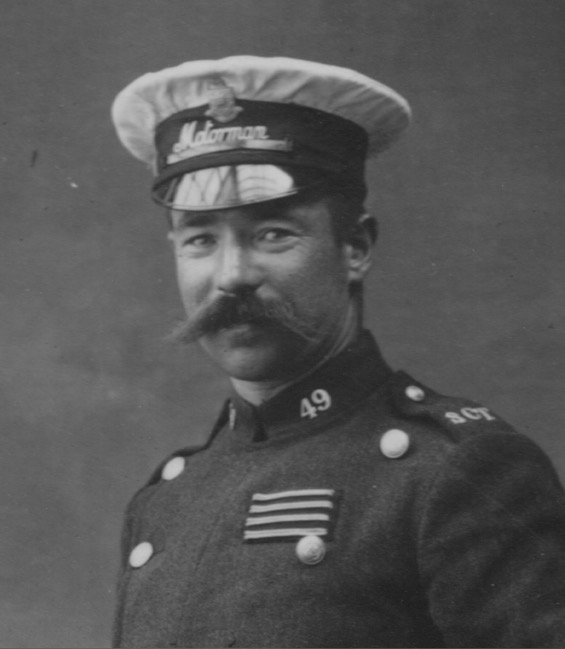
A blow-up of the above photo showing details of the cap, collar and epaulette insignia, as well a four-bar cloth badge on his left breast.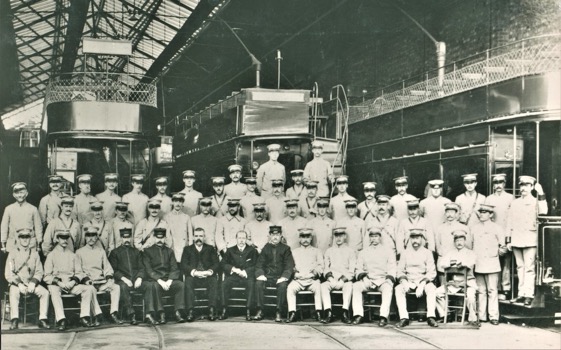
A staff photo taken at the tram depot on London Rd, probably to mark the issue of new 'German grey' uniforms — photo taken c1908. Photo from the C L Rayner Collection, courtesy of Richard Delahoy.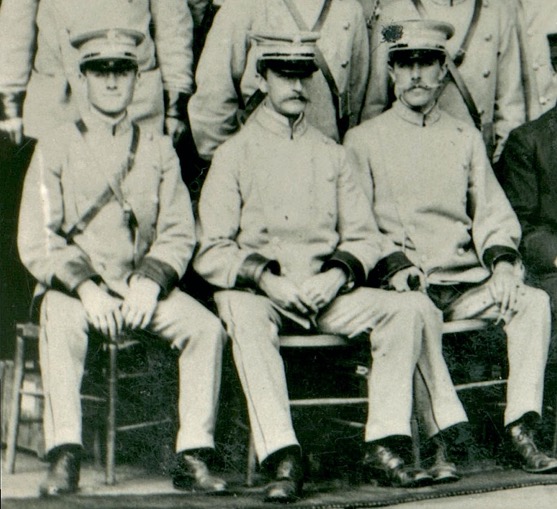
A blow-up of the above photo showing three of the tramwaymen. Although the jackets are in a fairly typical 'lancer style', the colour is unlike anything else ever used on a tramway in the British Isles. The caps are also unusual in being very tall, again more of a continental military style than British. The fact that the experiment was not repeated, probably tells us all we need to know about what the men and the public thought of them.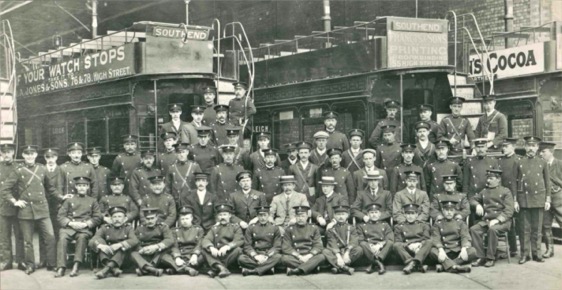
Another staff photo taken at the tram depot on London Rd, possibly to mark the issue of replacements for the 'German grey' uniforms — photo undated, but probably taken in 1909 or 1910. None of the jackets bear horizontal bar badges, even though later photographs clearly show them in use, so it may well be that the photograph was taken before the men had been able to transfer them from their old uniforms (assuming they remained the same colour and were therefore re-useable). Photo from the C L Rayner Collection, courtesy of Richard Delahoy.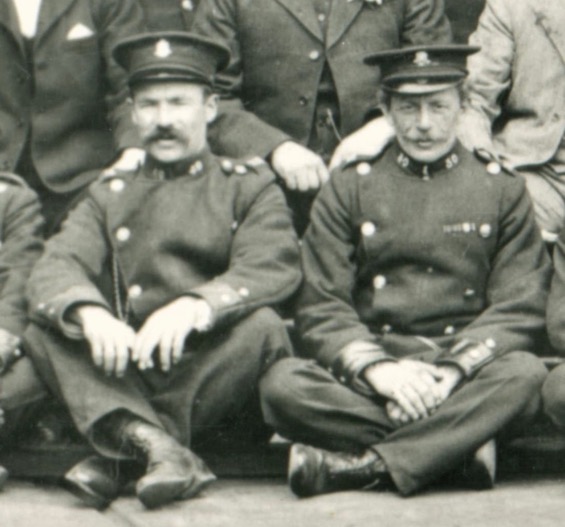
A blow-up of the above photo showing Motormen No 49 and No 50, studio portraits of whom are shown above. They are wearing new 'lancer-style' tunics with upright collars and epaulettes; their military-style caps however, now carry only the municipal shield badge, grade badges having been dispensed with.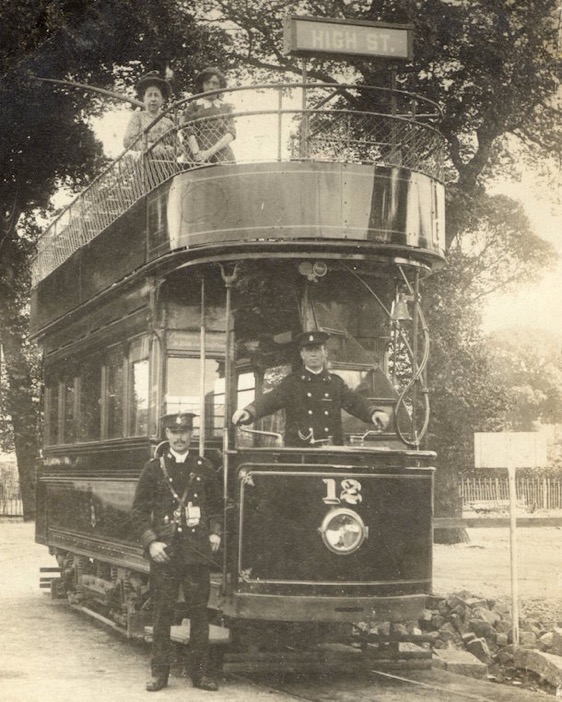
A conductor and a motorman pose with a very smartly turned-out Tramcar No 12 at Bournes Green, at the end of the newly completed Southchurch Boulevard track, dating the photo to between July 1913 and July 1914. Author's Collection.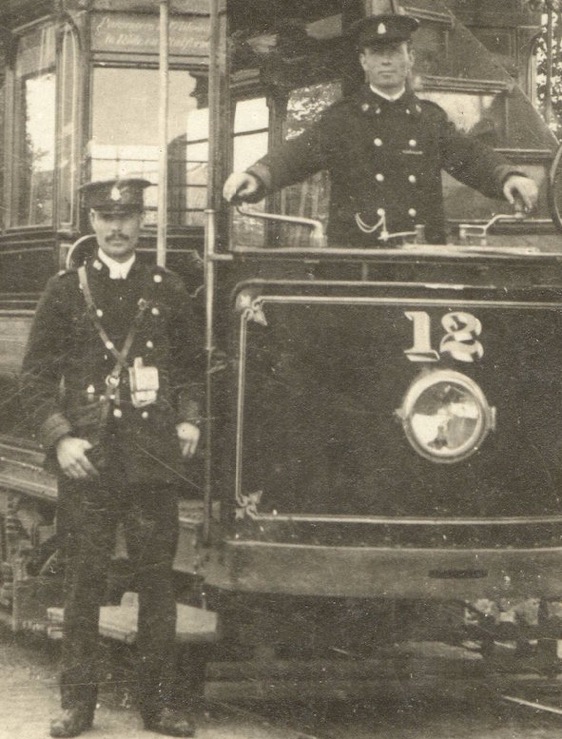
A blow-up of the above photo showing the conductor and motorman in greater detail.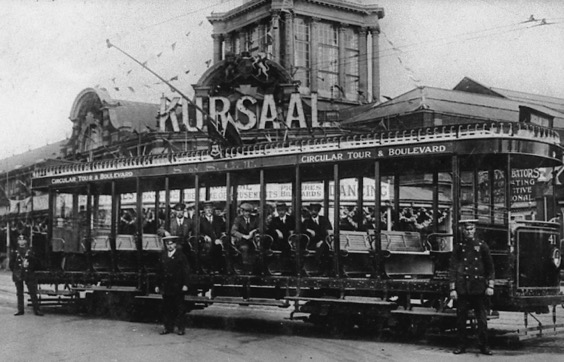
A postcard view of Tramcar No 14 on a circular tour service — although these started in 1914, this shot was possibly taken in 1915 or even after the Great War. The conductor (left) and motorman (right) are both wearing the usual 'lancer-style' tunics, but with script-lettering grade badges. Photo courtesy of the Tramways and Light Railway Society, with thanks to David Voice.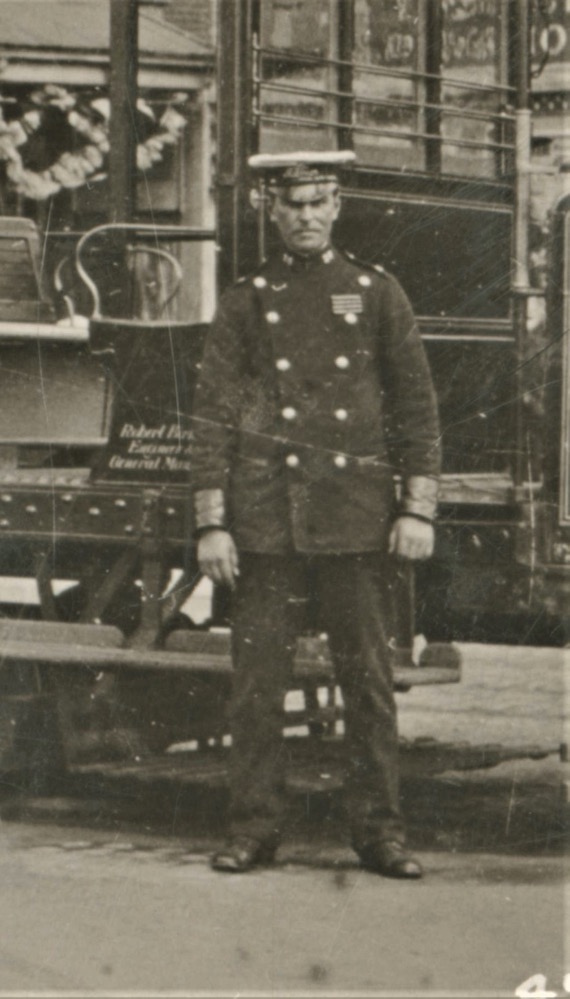
A blow-up of the above photo showing the motorman, who is clearly wearing a script-lettering grade badge (reintroduced during the Great War) and a badge on his left breast comprising four horizontal bars.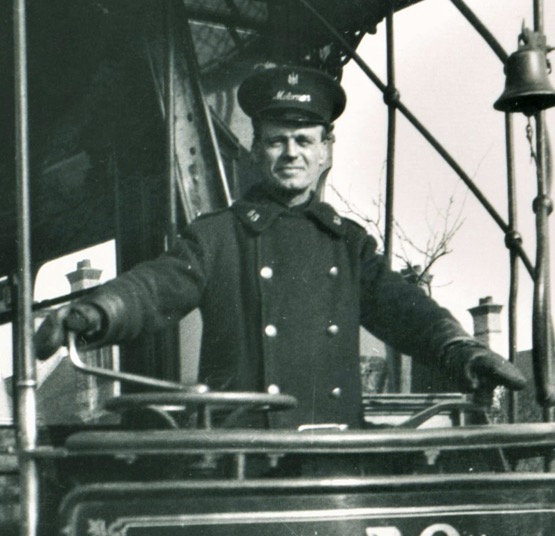
A motorman at the controls of Tramcar No 10 — photo undated, but probably taken in the 1920s. He is wearing the third incarnation of the municipal cap badge, introduced in the Great War (see below) along with script-lettering grade badges. Photo from the R Sims Collection, courtesy of Richard Delahoy.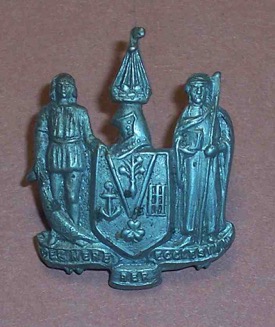
Southend-on-Sea Corporation Tramways cap badge — nickel — introduced during the Great War (following the grant of official arms on 1st January 1915) and worn through to the mid 1930s. Note the spelling mistake, 'MERE' rather than the correct 'MARE). My thanks to Alan Cook for this information. With thanks to the National Tramway Museum.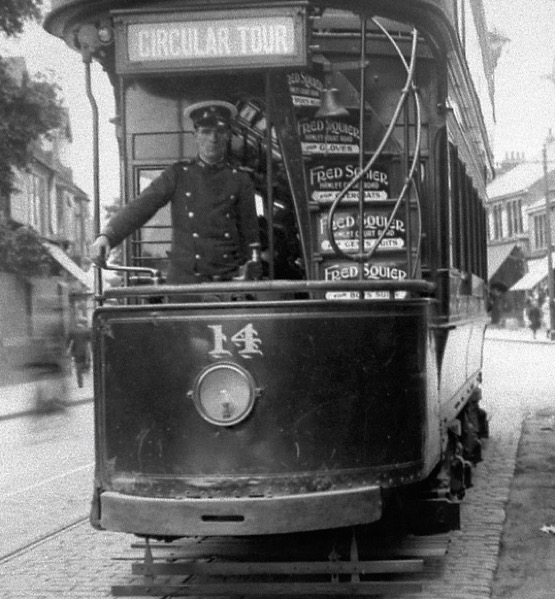
Motorman Essex at the controls of Tramcar No 14 in 1927. Source unknown.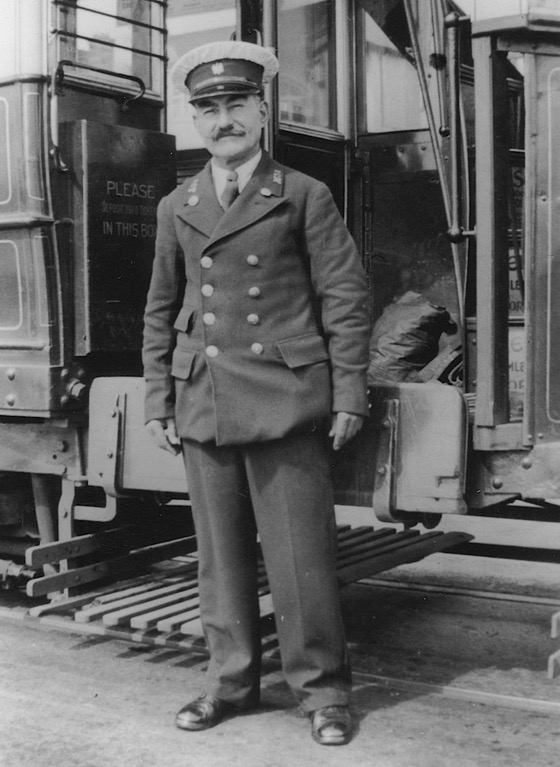
Southend-on-Sea Corporation Tramways motorman — photo undated, but probably taken in the mid 1930s. The uniform jacket had by this time been changed to a double-breasted naval style. With thanks to the National Tramway Museum.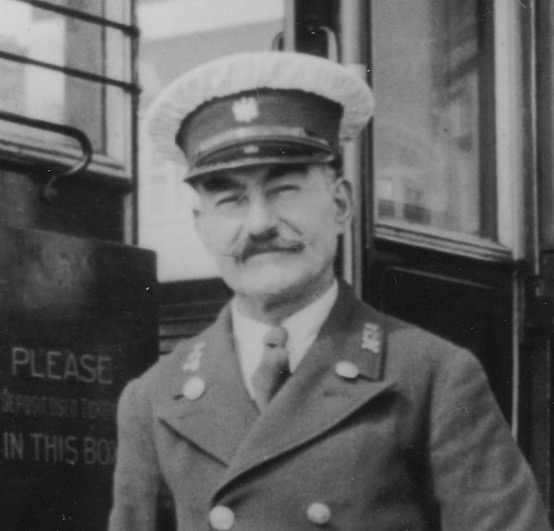
A blow-up of the above photo showing details of the collar insignia: 'M' and the employee number on the bearer's left-hand side, and 'S C T' on the right-hand side.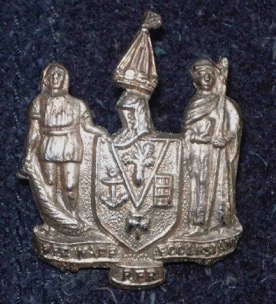
Southend-on-Sea Corporation Tramways cap badge — chrome — probably worn from the early to mid-1930s, though it may well post-date the demise of the tramway. Author's Collection.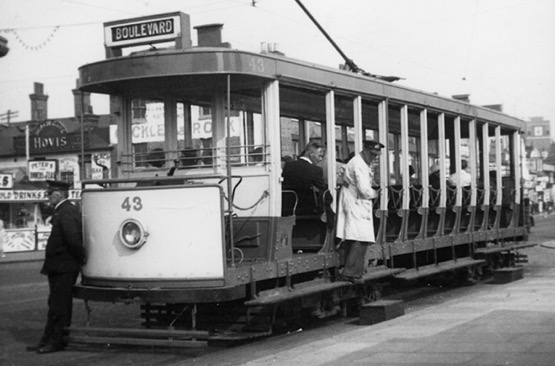
The motorman of Tramcar No 43 and his white-coated conductor captured on a Boulevard service — photo undated, but probably taken in the mid-to-late 1930s. Photo courtesy of the Tramways and Light Railway Society, with thanks to David Voice.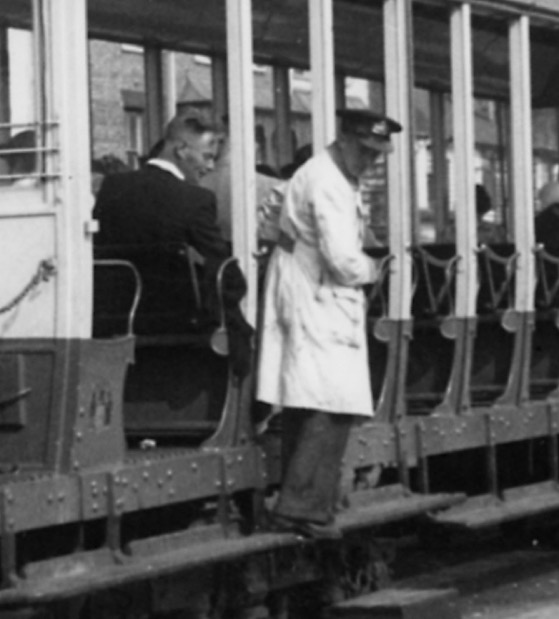
A blow-up of the above photo showing the conductor, in white dust coat and with the new 'Transport' cap badge.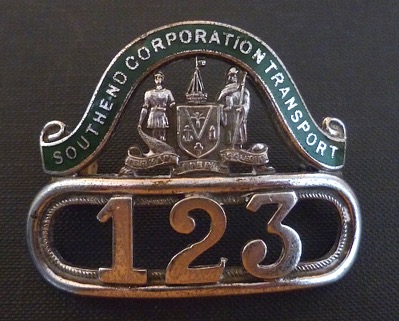
Southend-on Sea Corporation Transport cap badge No 123 — chrome and green enamel. This pattern of badge was introduced c1934 and was worn up until closure of the system in 1942.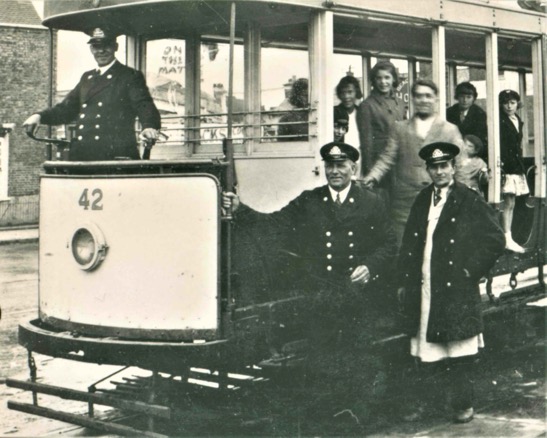
Two motormen and a conductor (in white coat) pose with Tramcar No 42 on the last day of circular tours, 6th July 1938, which looks to have been quite a chilly day. Photo from the C L Rayner Collection, courtesy of Richard Delahoy.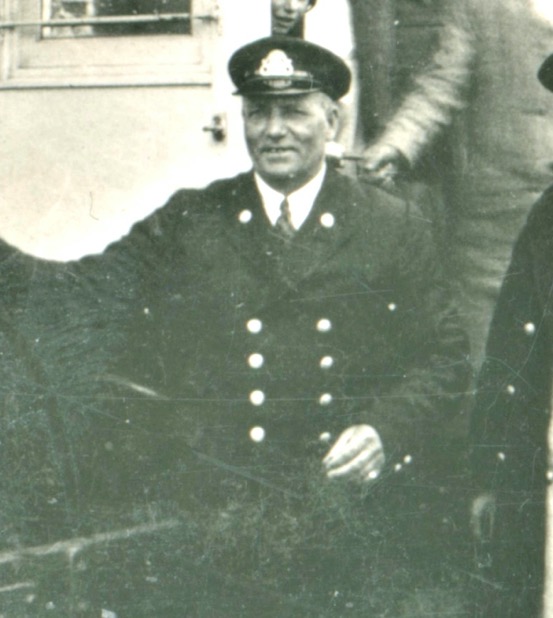
A blow-up of the above photo showing one of the motormen, in smart double-breasted jacket and with the new style of cap badge introduced around 1934 when the concern was re-named to 'Southend-on-Sea Corporation Transport'. Neither he nor the other motorman are wearing employee numbers on their collars.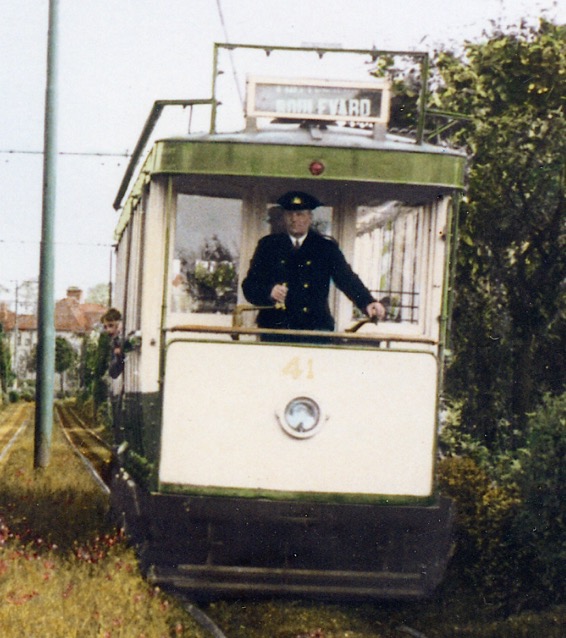
A rare colour shot of a motorman at the controls of Tramcar No 41 in the last summer of operation along the Boulevards. Photograph courtesy of the Tramways and Light Railway Society; photographer believed to be W A Camwell.
Senior staff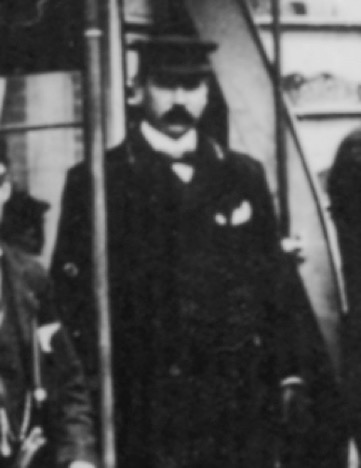
A blow-up of the 1901 shot above showing the inspector; he is wearing an overcoat with lapels, the upper part of which bears embroidered script-lettering, presumably his grade.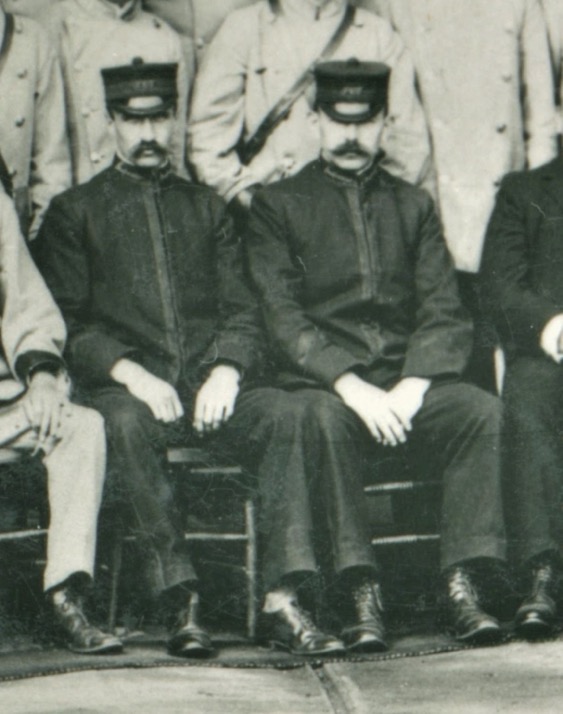
A blow-up of a larger staff photograph showing two inspectors — photo taken c1908. Both men are wearing typical tramway inspector garb; the collars bear the grade — Inspector — in embroidered script lettering, whilst the caps, which have a pom pom on top, bear what would appear to be embroidered system initials: S C T. Photo from the C L Rayner Collection, courtesy of Richard Delahoy.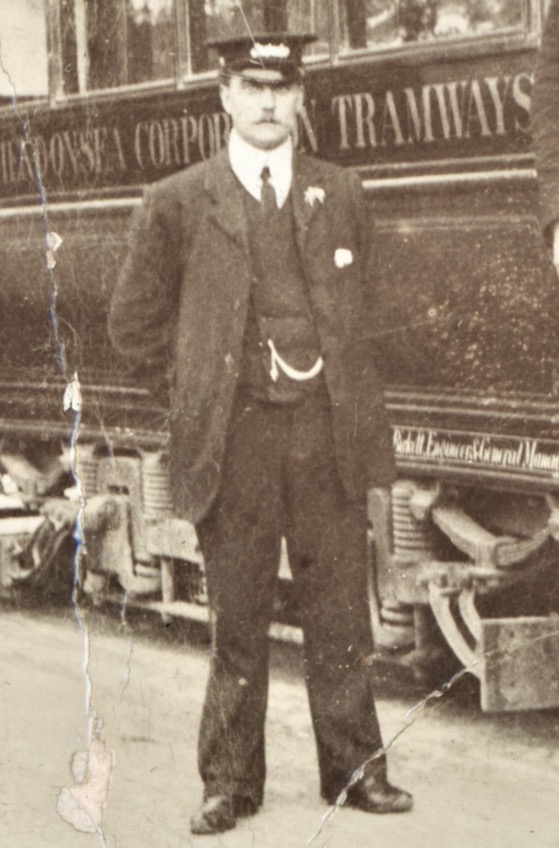
Inspector Tom Mowbury (or Mulbery) standing alongside Tramcar No 5 — from a postcard dated the 28th July 1909. He would appear to be wearing an informal (or at least unmarked) jacket, along with a military-style cap bearing a script-lettering grade badge, presumably in nickel. Photo from the C L Rayner Collection, courtesy of Richard Delahoy.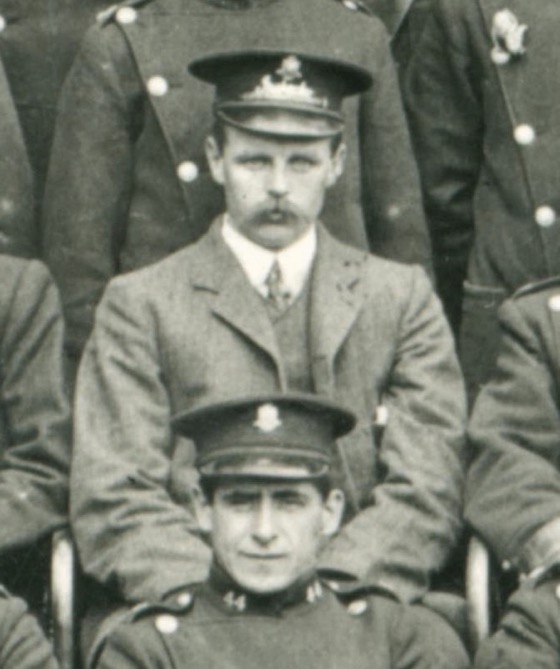
A blow-up of the circa 1909/10 staff photo above showing Inspector Mowbury (or Mulbery). Once again, he is wearing an informal jacket, though his cap now has the municipal shield badge as well as a grade badge.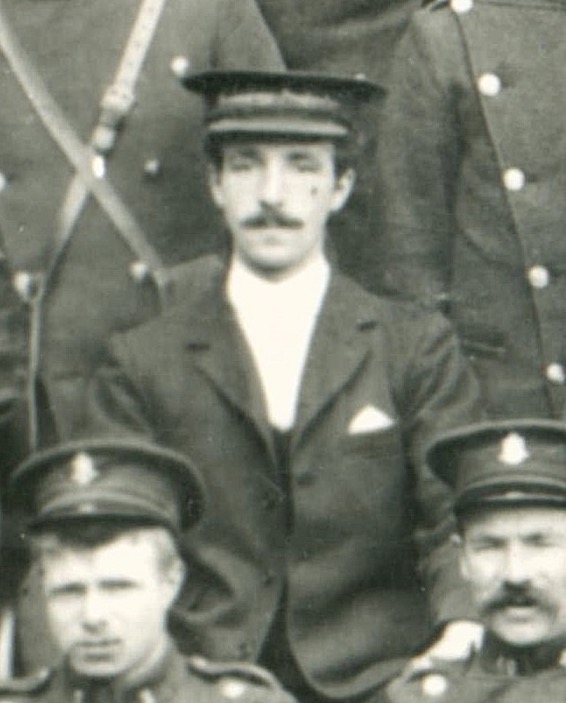
Another blow-up of the 1909/10 staff photo showing another inspector. He is also wearing an informal jacket, but with a cap bearing his grade — Tramway Inspector — in embroidered script lettering. This and the two previous photos suggest that new uniforms were yet to be delivered, so in the meantime, makeshift uniforms were cobbled together.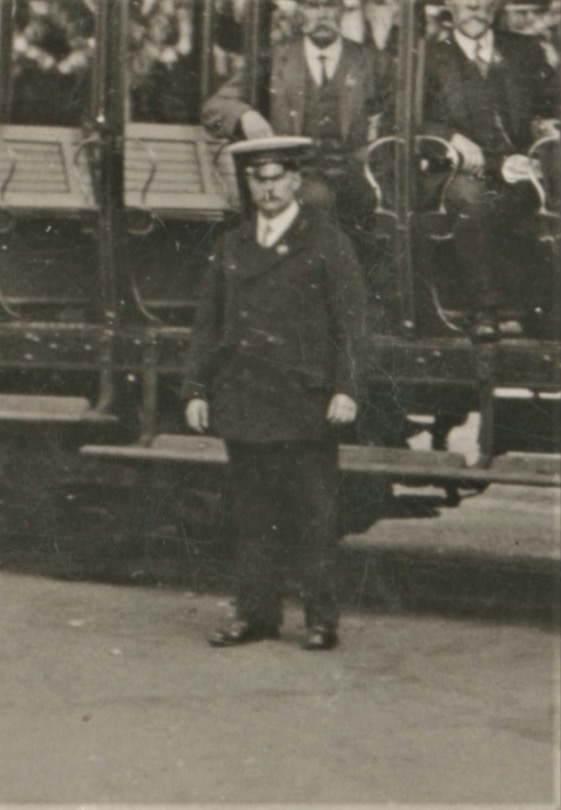
A blow-up of the circular tour photo above, taken during or shortly after the Great War. By this time, inspectors had been issued double-breasted jackets with lapels, the latter bearing embroidered grade badges. Photo from the C L Rayner Collection, courtesy of Richard Delahoy.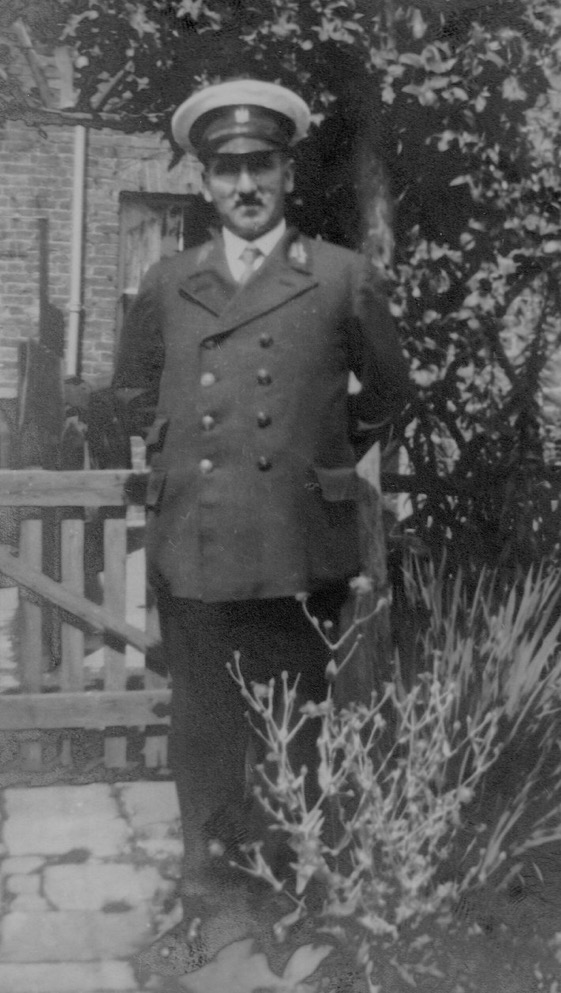
An informal portrait of Henry Louis Wittick, who died aged 61 years on the 24th May 1935 — photo undated, but probably taken in the early 1930's. His jacket would appear to bear black buttons, along with a two-line collar badge, suggesting that his was probably the Chief Inspector. The photograph was copied as a memento, and was presumably given (in a little card folder) to friends, colleagues and family. This particular one was in the possession of Motorman Christopher Hebden, who worked for the SSCT from 1919 through to closure. My thanks to Chris Hebden's grandson, Mike Hebden, for the background information. Author's Collection.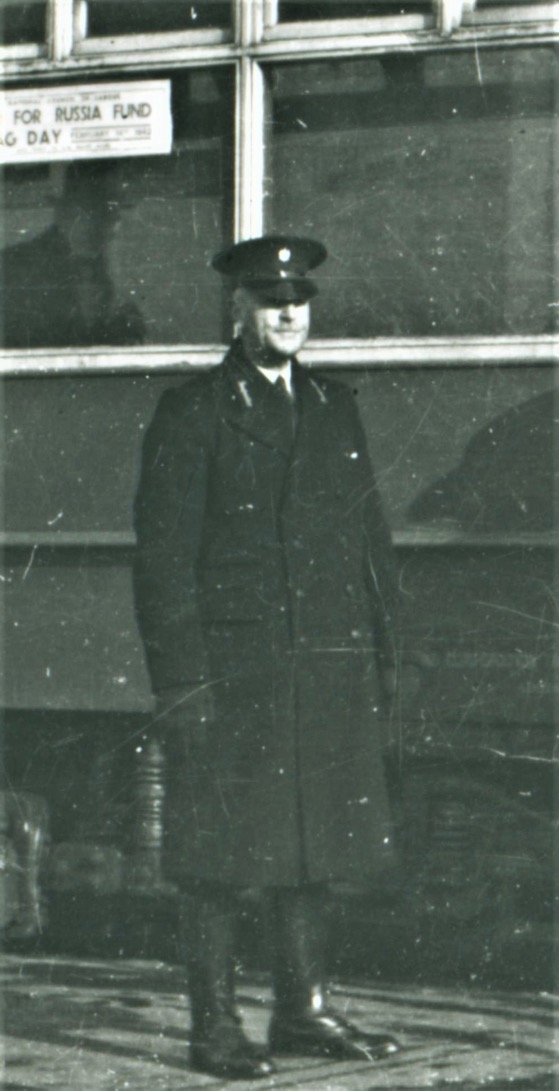
An SSCT inspector, captured on the 2nd February 1942. His overcoat lapels bear his grade in embroidered script-lettering, whilst his cap bears the standard municipal device badge. Photo courtesy of the Richard Delahoy Collection.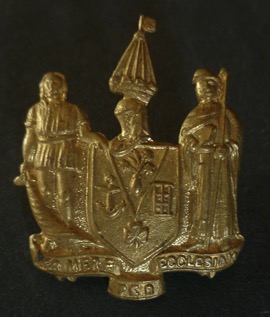
Southend-on-Sea Corporation Tramways cap badge — brass — possibly worn by senior grades from the Great War onwards. Author's Collection.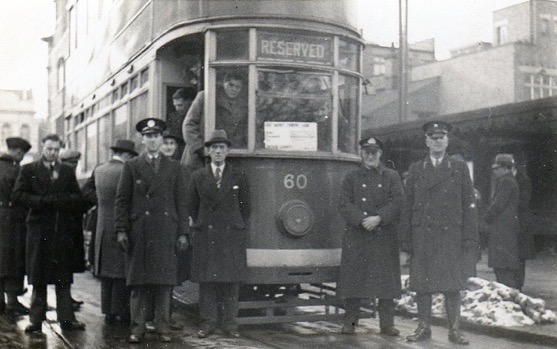
Tramcar No 60 posed for the cameras of the Light Railway Transport League in Warrior Square on the 8th February 1942, just two months prior to closure. The man on the right is almost certainly an SSCT inspector.
Female staff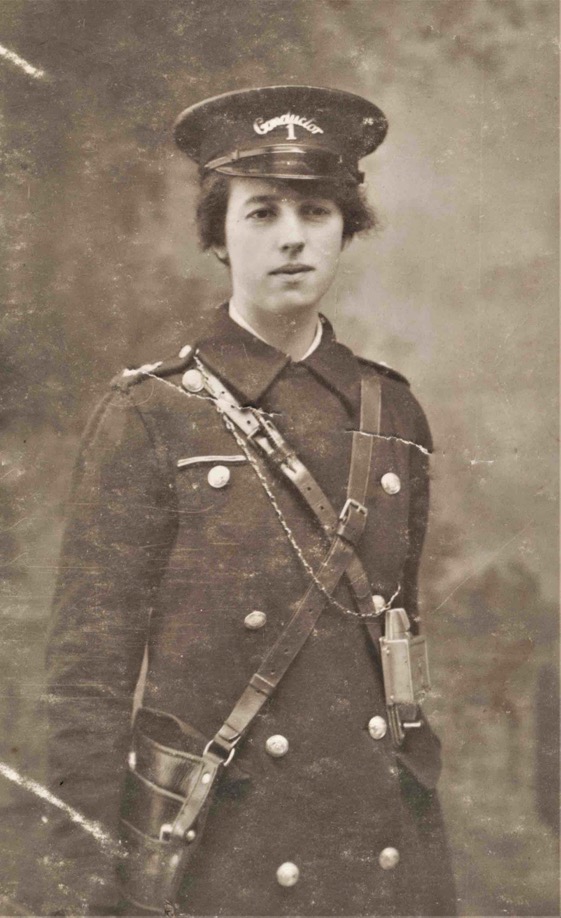
SSCT Great War conductress May Patterson (later Rayner), Employee No 1. The greatcoat bears a horizontal cloth bar on the bearer's right-hand breast, possibly signifying seniority or good conduct. Photo from the C L Rayner Collection, courtesy of Richard Delahoy.![]()
A studio portrait of a Southend-on-Sea Corporation Tramways Great War conductress, Employee No 62. Author's Collection.![]()
A blow-up of the above photo showing details of the uniform, including the shield-shaped cap badge usually worn by male staff, but infrequently by female staff. Magnification of the buttons (not shown) reveals them to be the standard borough pattern with title and sailing ship (see link).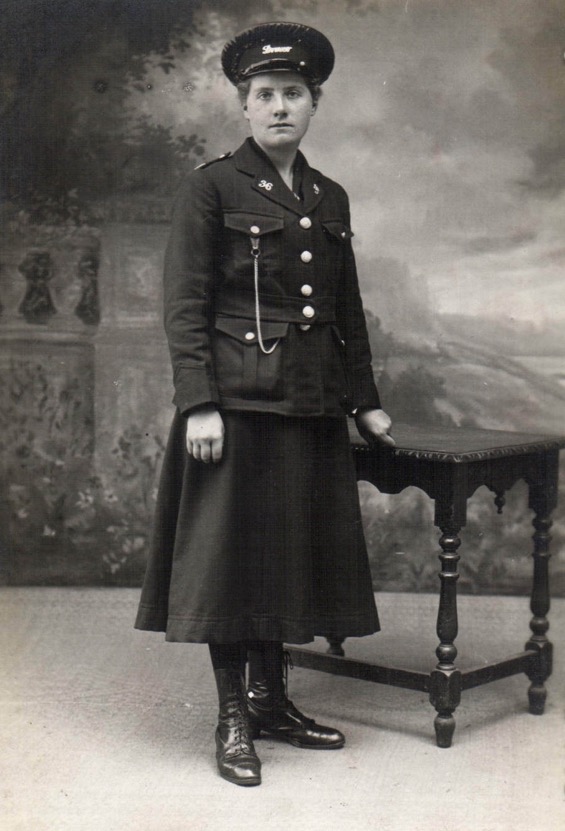
A studio portrait of an unknown SSCT Great War motorwoman, Employee No 36. Presumably the council thought that Motorman grade badges were inappropriate, hence the use of the genderless Driver badges. Photo courtesy of the Richard Delahoy Collection.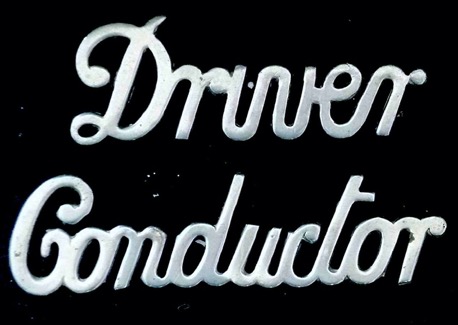
Standard, 'off-the-shelf', script-lettering grade badges of the type used by the SSCT for female staff — nickel. Author's Collection.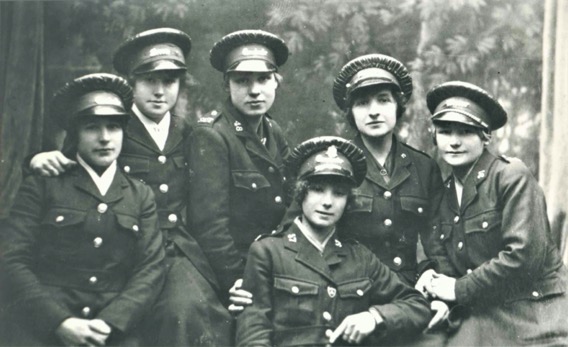
A studio portrait of a group of SSCT Great War conductresses and motorwomen. Photo from the C L Rayner Collection, courtesy of Richard Delahoy.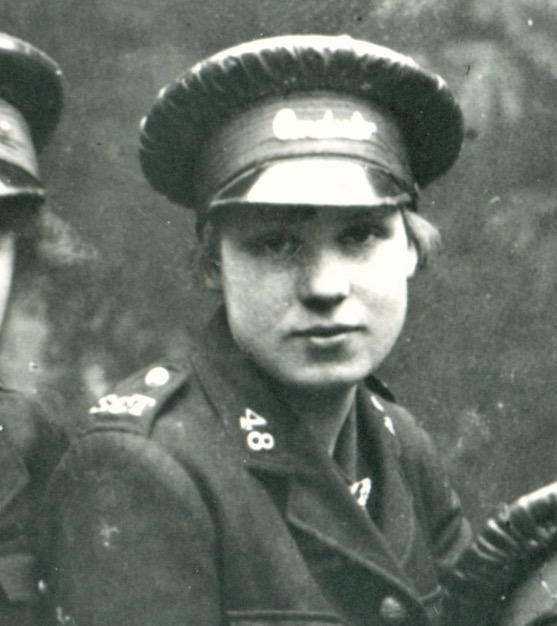
A blow-up of the above photo showing one of the conductresses (Employee No 48). Her epaulettes clearly bear system initials, SCT.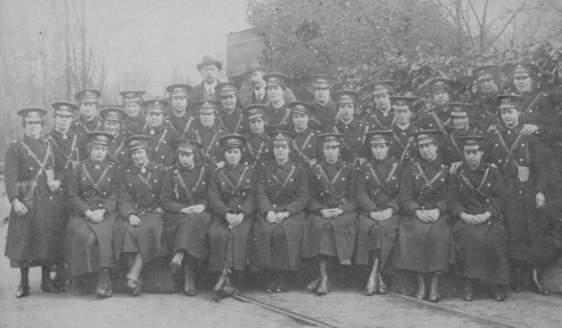
A group of 30 Southend-on-Sea Corporation Tramways conductresses — photo undated, but almost certainly taken during the Great War. Whereabouts of original unknown.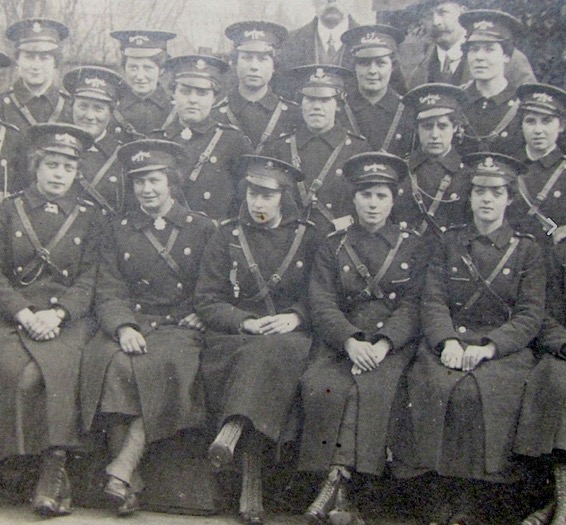
A blow-up of the above photo revealing that all present are wearing 'lancer-style' greatcoats with epaulettes, with long skirts.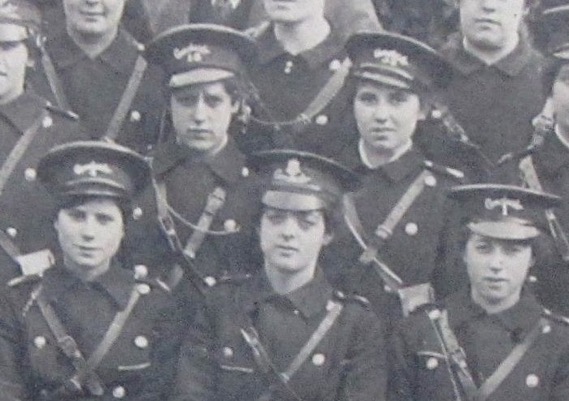
Another blow-up of the same photo showing the caps, which appear to be identical to those worn by their male colleagues. Unlike the latter, the script-lettering grade badge is complemented — in most cases — by an employee number, though the lady shown in the centre has the more familiar municipal badge. The lady at the bottom right is May Patterson (see studio portrait above).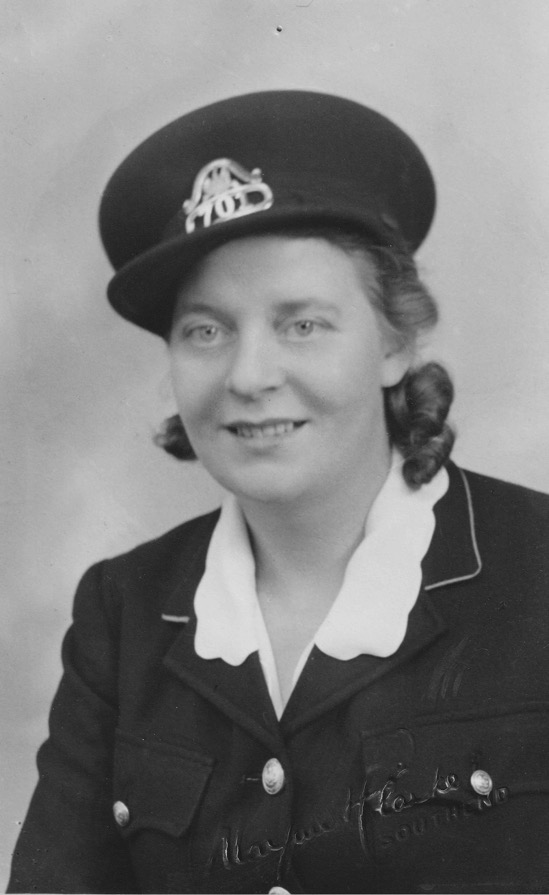
A Southend-on-Sea Corporation Transport employee (No 701), probably a conductress. The photograph was probably taken during or shortly after the Second World War in the studios of Margaret Clarke.